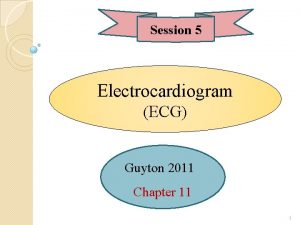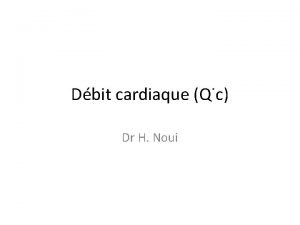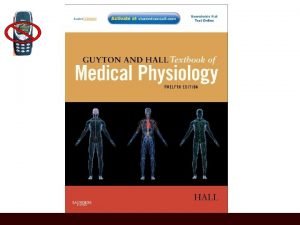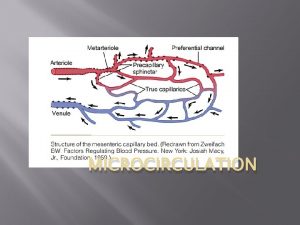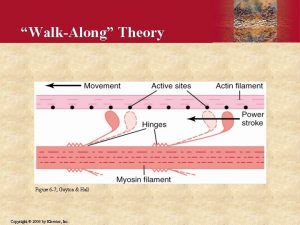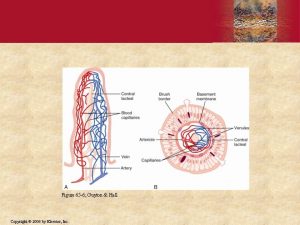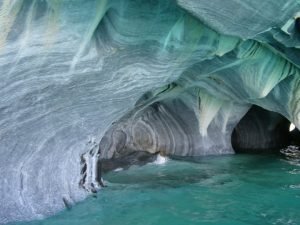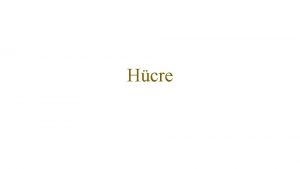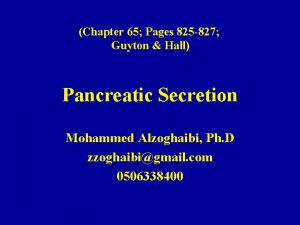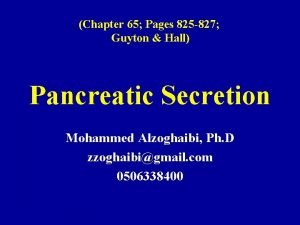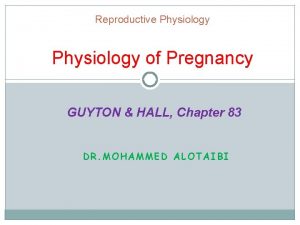The Microcirculation Figure 16 1 Guyton and Hall















- Slides: 15

The Microcirculation Figure 16 -1; Guyton and Hall Copyright © 2006 by Elsevier, Inc.

Structure of Capillary Wall Figure 16 -2; Guyton and Hall Copyright © 2006 by Elsevier, Inc.

Interstitium and Interstitial Fluid Copyright © 2006 by Elsevier, Inc. Figure 16 -4; Guyton and Hall

Determinants of Net Fluid Movement across Capillaries Figure 16 -5; Guyton and Hall • Capillary hydrostatic pressure (Pc)-tends to force fluid outward through the capillary membrane. • Interstitial fluid pressure (Pif)- opposes filtration when value is positive. Copyright © 2006 by Elsevier, Inc.

Determinants of Net Fluid Movement across Capillaries Figure 16 -5; Guyton and Hall • Plasma colloid osmotic pressure ( c)- opposes filtration causing osmosis of water inward through the membrane • Interstitial fluid colloid pressure ( if) promotes filtration by causing osmosis of fluid outward through the membrane NP = Pc - Pif + if Copyright © 2006 by Elsevier, Inc.

Plasma Proteins and Colloid Osmotic Pressure • 75% of the total colloid osmotic pressure of plasma results from the presence of albumin and 25% is due to globulins. Albumin Globulins Fibrinogen Total Copyright © 2006 by Elsevier, Inc. gm/dl 4. 5 2. 5 0. 3 7. 3 p(mm. Hg) 21. 8 6. 0 0. 2 28. 0

Determinants of Net Fluid Movement Across Capillaries Figure 16 -5; Guyton and Hall • Filtration rate = net filtration pressure (NFP) multiplied by the filtration coefficient • Filtration coefficient (Kf) is a product of surface area times the hydraulic conductivity of membrane Copyright © 2006 by Elsevier, Inc.

Forces Causing Filtration at the Arteriole End of the Capillary mm. Hg Forces tending to move fluid outward: Capillary pressure 30 Negative interstitial free fluid pressure 3 Interstitial fluid colloid osmotic pressure 8 TOTAL OUTWARD FORCE 41 Forces tending to move fluid inward: Plasma colloid osmotic pressure 28 TOTAL INWARD FORCE 28 Summation of forces: Outward 41 Inward 28 NET OUTWARD FORCE Copyright © 2006 by Elsevier, Inc. 13

Forces Causing Reabsorption at the Venous End of the Capillary mm. Hg Forces tending to move fluid inward: Plasma colloid osmotic pressure TOTAL INWARD FORCE Forces tending to move fluid outward: Capillary pressure Negative interstitial free fluid pressure Interstitial fluid colloid osmotic pressure TOTAL OUTWARD FORCE Summation of forces: Outward Inward NET INWARD FORCE Copyright © 2006 by Elsevier, Inc. 28 28 10 3 8 21 21 28 7

Net Starling Forces in Capillaries mm. Hg Mean forces tending to move fluid outward: Mean Capillary pressure Negative interstitial free fluid pressure Interstitial fluid colloid osmotic pressure TOTAL OUTWARD FORCE 17. 3 3. 0 8. 0 28. 3 Mean force tending to move fluid inward: Plasma colloid osmotic pressure TOTAL INWARD FORCE 28. 0 Summation of mean forces: Outward Inward NET OUTWARD FORCE 28. 3 28. 0 0. 3 Copyright © 2006 by Elsevier, Inc.

Net Starling Forces in Capillaries Figure opener; Guyton and Hall • Net filtration pressure of. 3 mm. Hg which causes a net filtration rate of 2 ml/min for entire body. Copyright © 2006 by Elsevier, Inc.

Question Utilizing the data below, calculate the rate of net fluid movement across the capillary wall: Pressures (in mm. Hg) Plasma colloid osmotic = 20 Capillary hydrostatic = 20 Venous hydrostatic = 5 Arterial = 80 Interstitial hydrostatic = -5 Interstitial colloid osmotic = 5 Filtration coefficient = 10 ml/min/mm. Hg a. 0 ml/min d. 100 ml/min (Reabsorption) b. 10 ml/min (Filtration) e. 10 ml/min (Reabsorption) c. 100 ml/min (Filtration) Copyright © 2006 by Elsevier, Inc.

Lymphatic System Copyright © 2006 by Elsevier, Inc.

Determinants of Lymph Flow Figure 16 -11; Guyton and Hall • The degree of activity of the lymphatic pump - smooth muscle filaments in lymph vessel cause them to contract - external compression also contributes to lymphatic pumping Copyright © 2006 by Elsevier, Inc.

Determinants of Lymph Flow Interstitial fluid hydrostatic pressure Lymph Flow Figure 16 -9; Guyton and Hall Figure 16 -10; Guyton and Hall Copyright © 2006 by Elsevier, Inc.
 White pulp
White pulp Guyton
GuytonErythropoiesis guyton
 Ecg guyton
Ecg guyton Précharge et postcharge def
Précharge et postcharge def Guyton physiology lectures
Guyton physiology lectures Manuela gardner
Manuela gardner Congenital adrenal hyperplasia
Congenital adrenal hyperplasia What is 6 figure grid reference
What is 6 figure grid reference Hình ảnh bộ gõ cơ thể búng tay
Hình ảnh bộ gõ cơ thể búng tay Frameset trong html5
Frameset trong html5 Bổ thể
Bổ thể Tỉ lệ cơ thể trẻ em
Tỉ lệ cơ thể trẻ em Gấu đi như thế nào
Gấu đi như thế nào Tư thế worm breton
Tư thế worm breton Bài hát chúa yêu trần thế alleluia
Bài hát chúa yêu trần thế alleluia


